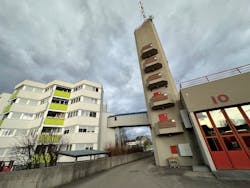As Firehouse Sees It: Visiting Austria’s Fire Brigades
After a week in Austria during which I visited fire stations and with manufacturers and broke bread with firefighters, I developed a greater understanding of how firefighting happens beyond the United States and a new respect for what those people do, despite the opinions of many outsiders. What I found is that, through trials and tribulations, it works for the fire brigades based on staffing, common fire conditions and building construction.
Shockingly, a similar story to what we’ve been hearing here emerged: the struggle to retain volunteer firefighters and to attract new ones. Although the Austrian government provides various levels of funding and equipment to suburban and rural areas, the local departments still must work to train and to find the money to provide the various services.
I spent a day at the Alkoven Fire Brigade with volunteers who give countless hours of their time to the citizens of the community. (The station also serves as a social gathering place for members and citizens.) The small group of volunteers staffs an engine, tanker, ladder, heavy duty (think big city) crane apparatus, multiple boats for operations on the Danube River, and other emergency vehicles to protect their community and adjacent ones. It’s a collective effort of neighbors helping neighbors once you are outside of the city, and the members do it simply for the sake of pride.
We talked about firefighter cancer, and although they are aware of the increased risks to firefighters, they responded that firefighter cancer is relatively low in Austria, which was encouraging to hear. First, there’s much lower exposure to fires and their aftermath compared with here in the United States. Second, building construction generally keeps fires more contained, and there is less synthetics, fuels and other toxic material to burn. Third, the approach to firefighting tactics, including with limited smoke spread via curtains and ventilation, also plays a big role.
Further, firefighters remain on breathing air anytime they are in an IDLH space. Also, the chain of decontamination starts early, and members are quick to complete all steps: immediate on-scene decon of PPE and equipment, followed by strict, personal decontamination of the body and changing out of duty clothes on scene, to showers on return to the station.
Austria’s fire brigades continue to innovate and to improve their tactics, operations and emergency vehicles as things change. Despite the centuries-old buildings there, the brigades use modern tactics and continue to re-evaluate as needed.
In the coming months, I’ll write additional articles about my experiences and observations that I believe will be helpful to you. Several programs and concepts can be adapted in the United States—and I was reminded of the old adage of “don’t knock it until you’ve tried it.”
I would like to thank Hermann Kollinger, who is a firefighter in Alkoven and the editor of Brennpunkt magazine (which is similar to Firehouse), for bringing my knowledge up several notches and for helping me with a memorable trip, during which I met incredible firefighters who I now am glad to call friends. Danke.
About the Author
Peter Matthews
Editor-in-Chief/Conference Director
Peter Matthews is the conference director and editor-in-chief of Firehouse. He has worked at Firehouse since 1999, serving in various roles on both Firehouse Magazine and Firehouse.com staffs. He completed an internship with the Rochester, NY, Fire Department and served with fire departments in Rush, NY, and Laurel, MD, and was a lieutenant with the Glenwood Fire Company in Glenwood Landing, NY. Matthews served as photographer for the St. Paul, MN, Fire Department and currently is a photographer for the Fort Worth, TX, Fire Department.




